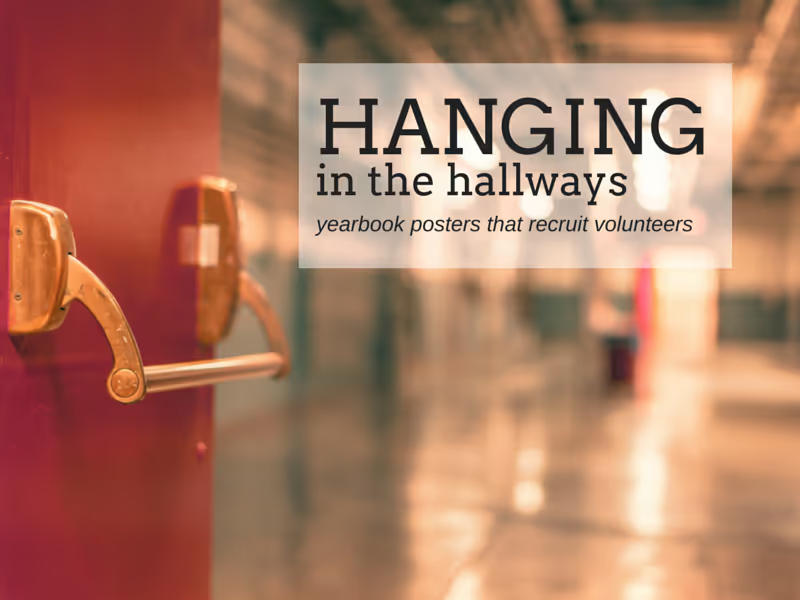Yearbook curriculum
Looking for inspiration, design tricks, how to make a great cover, promoting your yearbook and engaging your community?
Most recent

June 25, 2015
Take a break from the yearbook committee: 3 creative ideas that will bring you back refreshed
As you’ve recently experienced, being the person in charge of the yearbook committee can be a slightly intense undertaking. This is never truer than at the end of the school year, when you’re working to get all of your content created, proofed, and added to your template before your delivery deadline. And that means summer break can’t possibly come at a better time. But while you’re relaxing and refreshing your mind during the warmest months of the year, don’t forget to take some time to engage your creative side! Below, I’ve come up with some fun activities that will help you have a great summer, and also give you some engaging new exercises for creativity that you can bring back to your committee in the fall.
Funny Videos
If there’s one thing that can get you laughing, it’s a compilation of funny videos on YouTube. So on those days it's too hot to venture outside (or too rainy), jump online and spend a few hours enjoying cute kittens, adorable babies or people pulling pranks on their significant others. As you find a few that really get you giggling, save them in an email or a spreadsheet that you can refer back to during the school year. While these videos will help you to relax after a stressful publication season, they’re also a great tool for breaking up or starting off a committee meeting with something hilarious when you all come back together in the fall!Music Playlist
Music is a great way to spur creativity. It’s also an excellent tool to help you unwind. This summer, spend some time pulling together a great playlist of all your favorite music, past and present. Try to incorporate some artists that may be less well-known to your committee, as changing rhythms, tones and timbres have been shown to really engage the creative side of your brain.1 Personally, I find that a playlist full of songs without words really helps when reading, writing, or editing. This summer, you can use this playlist at the beach, while you’re working on your house or mowing the lawn, or as you’re pulling together your class syllabi for the school year. Then bring your playlist to your yearbook committee meetings to share with your team in the fall!Practice Exercises
Building creativity--both for yourself and among your yearbook committee--means accessing both the left and right sides of your brain. To really engage your ingenuity, you need exercises that work both sides of your brain at the same time. Here are a few great ones to get you started:- Look for new ideas: To think outside of the box on a more regular basis, you have to train your brain to look for creative ideas when you’re living everyday life. To make this a priority, you need the right tools to capture ideas on the go. While a pen and paper will work fine, you can also use apps like Evernote and Backpack. Both are easy to access and offer sharing capabilities, making it simple to send new concepts to the rest of your team when you’re out and about!
- Use your non-dominant side: Giving yourself a challenge by using your non-dominant hand in normal activities can stimulate both sides of your brain. Practice writing, catching a ball and picking things up with your opposite hand to get those synapses firing!
- Practice your colors: One way you can start encouraging the right and left sides of your brain to communicate better is through a color exercise. Write down different colors on a piece of paper using a marker of another color. For example, write yellow in a blue marker, green in a purple marker, etc. Then practice reading the name of the color as written. While it may not be the most thrilling party trick, it’s actually much more difficult than it sounds!
Spark Creativity Within Your Yearbook Committee
Taking a break from your yearbook committee during the summer months gives you plenty of time to refresh your mind before coming back to school in the fall. These particular tips are excellent ways to stimulate your creativity and take a break from planning and scheduling, yet they can carry into fall and be tools your yearbook committee will use. So watch some videos, relax to some tunes, and exercise your brain in silly ways. Before you know it, you’ll have a bunch of new ways to get your committee off on an innovative foot in the fall, while also enjoying your summer break! 1. https://www.sciencedaily.com/releases/2011/12/111205081731.htm
June 17, 2015
An organized yearbook adviser: how to create a yearly calendar that works
Although you’ll likely take the month of June to relax and rejuvenate after a long year in the classroom, you’ll eventually want to start planning for next year’s yearbook. One of the tools that you should begin building during these months is a calendar that tracks all of the dates that affect your role as yearbook adviser throughout the year. From brainstorming to editorial due dates to when your committee members will be on vacation, this will become essential to planning your content. Below, I’ll walk you through the most important things to include on your calendar, and how to utilize this important tool for success throughout the school year.
Start With a Project Timeline
Before you build your calendar, create a project timeline in a spreadsheet. This allows you to first detail out each of the small projects and features that will become part of your publication. Once complete, you can share this timeline with your committee to keep your team on track. As the yearbook adviser, a timeline makes it easier to visualize all of the dates that comprise a specific project or feature, to ensure that nothing slips through the cracks. To start working on your own timeline, we have a Google Doc you can use to plan your year! Once your timeline is complete, start adding those dates to your yearbook calendar, so that you’re always aware of what’s coming up across all of the projects your team is working on, with one glance.Add Important Dates from the School Calendar
As you’re thinking through the specific projects you’ll assign out to your committee, start adding some of the more important school events to your calendar. This includes big fundraisers, the school art fair, sports events, dances, etc. Anything major that you want to cover in the pages of your publication should wind up on your calendar. This helps you plan out who will cover big events in advance, instead of leaving everything until the last minute. You should also include any dates that are important to your committee, so that you can recognize what your team has going on as you’re assigning out content. This includes birthdays, vacations, and events that they’re participating in themselves, and therefore can’t cover. If three of your students are part of the school’s show choir, mark out their major performances. If one of your students is in the school play, make sure you note that on your calendar. This keeps all of your important date information in one centralized location. You can then use this information to plan out a month of committee activities in advance, including who will cover specific stories, knowing who has time to edit content, and more. Once you’ve assigned out content, make sure you add the name of the responsible committee member to each of the deadlines in your calendar--or, better yet, 'invite' them to the event! Now they'll get an email reminder of this event, and can add it to their own calendar, so you know they know.Include Ideas
If you have an awesome activity or exercise that would be perfect for a specific committee meeting, add it to the “notes” section of your calendar appointment. This helps you stay organized, so that you’re not constantly searching for the sticky note with that great idea at the last minute, or worse, forgetting to use it all together. To add notes to your schedule in a Google calendar, just open up the appointment and add your idea to the “Description” section, then click “Save.” To do this in your Outlook calendar, use the notes section at the bottom of your appointment. Then click “Save.”A Calendar for the Yearbook Adviser
As the yearbook adviser, you have the most dates and timelines to keep track of. Having this information in two locations--your calendar and your Google Doc timeline--makes your job easier. With your calendar, you can see exactly what’s happening for your publication on a particular day, week or month. Your timeline is more project-specific, so that you can track what’s been assigned out to your committee within each of your features, and help each committee member stay on track with their assignments. Both are important in their own way. By utilizing these two great tools together, you’re sure to be the most organized yearbook adviser on the block. And that translates to a much easier process for pulling your publication together!
June 3, 2015
Recruit your next yearbook committee: use posters and flyers to bring on the best
The end of the school year is a great time to start thinking ahead. In fact, right now is the perfect time to recruit students for next season’s yearbook committee! Some of the best ways to reach out to students are through posters in the halls and the use of flyers. While a traditional marketing tactic, there are a few tricks you can use to improve the content you incorporate that will immediately boost your circulation--and the number of students who respond to your query. Ready to get started? Below you’ll find three common mistakes that many yearbook advisers make, and how to remedy them!
Mistake #1: Using “Join the Yearbook Committee” as a Headline
If you title your poster or flyer with what you ultimately want students to do, you lose out on the opportunity to really engage them with how awesome the yearbook committee is. Always start with a captivating headline--just as you would the spreads within your book! You work with a team of students who love to brainstorm--so let's use them as a resource to create a unique title! Try to come up with a headline that draws the reader in and forces them to read more. Questions and bold statements that speak to a student’s wants will benefit you best. For example:Want to see more of yourself in the yearbook next year?
Looking for a way to meet spectacular new friends?
Need to build a more diverse resume for college?
By coming at your campaign from a “what’s in it for me” mindset of your student body, they’ll immediately be more interested in what you’re trying to recruit them for!Mistake #2: Weak Call to Action
You might be tempted to close your flyer or poster with a note that students should touch base with you before the end of the school year if they want to join. Or encourage them to email you. These calls-to-action aren't strong enough to spur an immediate response to join your yearbook committee. Instead, add a little urgency to your call-to-action at the bottom of your flyer. You can add a deadline, group size limit or an extra incentive to join today. Some great concepts include:Hurry - this yearbook committee invite closes June 15!
Don’t delay - we’re only adding five new members this year!
Join today, and don’t miss out on our fun committee outings this summer!
When students are given a timetable to join, they’re more likely to respond immediately.
Mistake #3: No Follow Up
It’s pretty common for yearbook advisers to distribute these types of flyers once, or just hang up one round of posters--and then wait for responses to come in. Because your students are inundated with messages from teachers and other campus groups all week long, you need to communicate your own offering multiple times to really get their attention. So distribute your flyers on three separate days of the week, at varying times of the day. For example, you can hand them out once at the beginning of the day, once during the lunch hour and once as everyone’s packing up to leave. Also, change up the location and message of your posters--catch their eye with something new! After the year is complete, send out an email to offer one final chance to sign up. If you only have parent email addresses, don’t be afraid to use them! They can certainly encourage their child to participate on your committee if they know you have spots available. Plus, connecting with your students in multiple ways drives home your message, and ensures you hit the widest range of potential yearbook committee members.Flyers and Posters Promote Your Cause
As you’re building out the content that you’ll include on your yearbook posters and flyers, focus on the positive. Use photos of your yearbook committee enjoying the project from this year. The familiar faces will create more of a personal connection with other students. Be sure to bullet out what made this season of the yearbook so successful, from your fabulous brainstorming sessions to how much fun the kids had getting out and taking pictures. Most of all, remind students that working on the yearbook committee means they get to put a little of their own touch on the final publication. Focusing on what’s important to your students will best communicate why the yearbook is a good fit, and translate to a lot more new faces on your team in the fall!
May 26, 2015
Yearbook ideas: use your leftover spring photos for a fundraising campaign
As you complete all of the spring sections for this year’s book, there are likely a bunch of leftover photos that didn’t make the cut. While many of these images are totally amazing, there just isn’t enough room for every picture you nab to wind up on the pages of your book. When this happens, you have options. One of my favorite yearbook ideas to get a little extra mileage out of your committee’s hard work is to use these photos for a fundraising campaign. Below, I’ll walk you through exactly how you can use these images to raise money for your school, and how to to make sure your fundraising campaign doesn’t impede on your yearbook sales goals.
Find the Right Photos
When you’re using your extra images for fundraising, your best bet is to go simple, Select just a few of the most fabulous leftover pictures to promote to the students at your school for best results. This helps to limit the amount of work your committee has to dedicate to the project, and makes it easy for students to select a few images to purchase. To start, narrow down the photos you’ll share to no more than five images per group, team, or club. Look for pictures that offer a unique perspective--something the students couldn’t have taken themselves. Make sure you get a range of photos to include everyone from each group, as students like pictures of themselves. When your campus has an opportunity to get professional photos with their friends, doing what they love, they’re more likely to buy and support your campaign.Package Them Well
To make this a successful fundraising effort, you need to package your photos to sell. Once you’ve selected a few of the spring activity images to share with each group or club, make it clear how they’ll be available. For example, will you be printing them in a variety of sizes, or only one? Will they be available for digital purchase, or only print? My personal recommendation is to offer each image in one size for print--either a 5x7 or an 8x10. Then make the photos available for digital purchase, which would allow students to print their own copies. By limiting the options, you’re able to share those fabulous photos with a wider range of the student body, but limit the amount of work that this type of endeavor creates for your committee.Make it a Yearbook Special
As you’re out talking with the students who would be interested in purchasing these extra shots, make your pricing model clear. Bring an example of each printed photo to show off the quality of your print job and get students excited to buy their own copy right now. To ensure that students don’t replace the purchase of a yearbook with a few photos from your fundraising campaign, promote your extra photos as a yearbook special. Once students purchase a copy of the yearbook, they have the exclusive opportunity to get a few of these extra awesome pictures as an add-on! Make sure you also communicate to the students that purchasing a copy of these images goes to support your school. Bring along order forms when you meet with each group, so that the excitement of seeing the images translates into fundraising sales. Bring along a tablet or laptop to make it easy for students to get their yearbook order in immediately, if they haven’t purchased one yet. Also, include a note about how they can order from home, in case they don’t have a way to purchase from school. Not only will this make sure that their priority is on getting a yearbook, it gets more orders in before the end of the year sales deadline. The benefits of this idea are twofold! Also, reach out to the parents or coaches/advisers of each team or group, to spread the word--family will definitely want to get in on these frameable photos of their children in action!Putting Yearbook Ideas into Action
Your committee has taken some amazing photos throughout the spring months, and it’s just not possible to include every single shot on the pages of your publication. This is one of the best ideas to make sure that those stunning images don’t go to waste, while also raising money for your school at the same time. And since students get access to a little something extra with their book purchase, this will be one of your more successful yearbook ideas yet!
May 12, 2015
3 things your yearbook committee must do the last week of school
As the school year begins to wind down, you might be wondering how to keep your yearbook committee occupied once the book is finalized. After all, isn’t all of the work done, outside of distributing the publication to the masses? In some ways, yes--which means you can all breathe a sigh of relief and relax. But it doesn’t mean that there’s nothing left to do this school year! Below, I’ll walk you through the three things you should consider doing with your committee before the end of the year, from prepping for next fall to ensuring no great idea gets left in the dust.
Note Successes and Failures
As your yearbook committee worked to implement all of your fabulous ideas this year, they built out some awesome content. They also had some serious learning experiences along the way that contributed to making your publication great. Once you send your book to print, set aside a day or two to talk with your committee about what went really well, and what challenges they encountered. Outline the steps they took to make their role within the yearbook committee efficient, and how they worked well with the group as a whole. Focus on what they did to overcome challenges, and how you can utilize these ideas to help the yearbook committee start off on the right foot next fall. From concepts that weren't implemented properly to inconsistencies with project management, this is a great way to learn more about what your committee’s experience was throughout the year, and how you can take your team, yourself, and your publication to the next level in the future.Gather Unused Ideas
With all the brainstorming you did with your team, there are sure to be some leftover ideas that could be totally workable within next year’s book! Work with your yearbook committee to build out a list of these concepts in Google Docs, along with a brief description of how you see each one being executed. This will add context to jog your memory next fall, if the concept sounds a little nebulous in nature. Make a note about this document on your calendar for the fall. This will remind you of your pre-prepped ideas, and ensure that you remember to use them in your first brainstorming session next year!Prepare for the First Month
We all know that the first month of school is one of the most hectic of the year. The best thing you can do to make this month run smoothly is be totally prepared in advance. Which makes right now the perfect time to lay out your first month of activities for when classes resume in the fall! This allows you to plan the rest of the year’s activities when school starts. Work with your yearbook committee to create a timeline based on the successes you had this year. Outline what features should be started right off the bat, and when you need to have your theme determined by. Set up a full schedule for your first month of meetings. This gets you super organized to immediately get next year’s committee focused and on track.Celebrate Your Yearbook Committee!
After you've completed these three end-of-year tasks, it’s important to take some time to have a little fun--and celebrate all of the hard work your yearbook committee put in this year! Plan a fun ice cream sundae party to show your committee how much you appreciate their hard work. You could even move your class outside to enjoy your sundaes with a little fresh air, to boot! Whatever you choose to do, setting aside some fun downtime will make your committee feel totally loved and appreciated. Plus, ending the year on a positive note prepares everyone to come back in the fall ready to make the yearbook committee even more awesome than it was before!
May 7, 2015
Yearbook ideas: use creative thinking to help students thrive today and beyond
As a yearbook coordinator, your job is twofold: to help your students learn the publication process and to produce a fabulous yearbook. But as a role model, you also have a responsibility to lead them down the path towards an amazing future. One way to do this is by helping them develop superior critical thinking skills. The yearbook committee is a way to engage the creative talents of your students, which encourages them to become better problem solvers in general. This is something that won’t just help them today, but supports their success later on in life. Today, I’m examining a TED talk, "Design Thinking--Maximizing Your Students' Creative Talent," that focuses on how you can maximize your students’ creative talent as a gateway for their future and offering applicable lessons for you to use with your team.
Problem Solving vs. The Right Answer
In school, children are often taught to create work that represents what a teacher wants to see--to 'jump through the hoops,' as it were. Instead of thinking outside the box to come up with unique--and possibly better--solutions to problems, they’re told that there’s only one right answer. This builds a learning environment that stifles innovation. When challenged with coming up with creative solutions, many children don’t even know where to start. Teaching them to unleash their imagination will support strong original content for your yearbook, and also teach your students how to change the way they approach everyday problems in their schoolwork and beyond.Design Thinking is a Process
To infuse creativity into how your students solve complex problems, they have to start by asking the right questions. After identifying a problem, challenge your students to get out into the community to look for answers. This will help them to understand the full scope of an issue and ultimately identify the best solution for a problem. At the beginning, your students will need your guidance to develop questions that get to the root of their story. As they practice, they'll hone their skills to be able to ask awesome questions right off the bat.Don’t Be Afraid to Fail
To apply this line of thought to your yearbook, have your students act like journalists to uncover unique stories for new features within your yearbook. Help them formulate and track questions and responses on a notepad that they can refer back to. As they review their notes, encourage your students to come up with five creative story topics that could result in an extraordinary article for your book. After gathering their data, encourage your students to test out some of the yearbook ideas they came up with. Use a storyboard to lay out what each concept would entail. This style of prototyping will help them make the connection between a great concept, and whether they have enough data to implement the idea. By showing your students how to test concepts out before committing to one, you teach them that it’s ok to fail a few times before they find success. Over time, this inspires them to think outside the box on a regular basis--which creates a more innovative student body as a whole.Creative Yearbook Ideas Go Beyond Today
Developing broader critical thinking skills that inspire kids to go beyond just finding the answer their teacher is looking for does more than support great yearbook ideas. It teaches your students how to be passionate about the work they do. Beyond this, when students are given the creative tools to solve complex problems, they develop a more strategic thought process for approaching their work. This supports their ability to not just succeed, but to thrive after they’re sent off into the real world. Work with your committee to use this concept and come up with unique yearbook ideas that shine. You’ll teach them to have fun with problem-solving, while giving them valuable tools for the future as well!
May 5, 2015
A fun way to tell your yearbook committee thank you for all their hard work
As we approach the last few weeks of the school year, you’re ecstatic to send your publication off to print. You’re also realizing just how much hard work your yearbook committee put into your project over the past few months. From how they covered school events to the way they carefully crafted every article, their diligence has definitely paid off. While you want to show them your appreciation, your budget doesn’t allow you to splurge on a big thank you gift. But before you feel defeated, let me offer one super cute way to show off your appreciation: a photo collage of your year together, using the custom pages of your yearbook! Not only is it a budget-friendly option, but it doesn't eat up much time to design at all! Below, I’ll walk you through what to include and how you can easily create this special gift without a big investment.
A Fabulous Yearbook Committee Photo Collage
The thing that I love about this concept is that it celebrates your big accomplishment (the yearbook going to print) while thanking your committee at the same time. And your team will love having something to remember all of the fun they had this year! As you start to select the right photos to use in your collage, remember that this particular piece should focus on the people who have been behind the scenes. Crowdsource selfies from your yearbook committee that were taken while out working on your book. Find silly images that you saved from some of your team meetings. Creating a stunning yearbook can be stressful, but you also had a ton of great times together. Remind your yearbook committee of those amazing, unforgettable moments with the images you choose for your collage.Use Custom Pages
To make your collage a total surprise, use the free yearbooks that you earn through your sales to gift to your yearbook committee members. Before you place the final order, personalize the custom pages of these books with your photo collage! Our drag and drop software makes it easy to quickly add your selected photos to the spread. And since you're already familiar with how to build out pages in our system, creating this custom work of art will be a breeze! Add a few quotes throughout your collage about friendship, either on your own or through the pre-made graphics that are available within your Treering account. Include a lovely header to the top of your collage that thanks your team for their dedication to the project. Since you're adding the collage to the custom pages of the yearbook, you can even personalize this header with each individual's name! With a few minutes' effort, you'll create something that your committee members will cherish forever.Personalize Your Yearbook Committee Thank You
Once you're ready to distribute the yearbooks, make sure you write a nice thank you note on the first signature page. This will always remind them of how hard they worked to help create something wonderful for your school. While they might lose a thank you card, you can be sure they'll keep this memory forever. Plus, this individualized touch will really resonate with your yearbook committee members. Within your note, make sure to:- Personalize the note with specific contributions that each individual made. This will recognize how their efforts supported the yearbook creation process, and why they were a valued member of your team.
- Include a fun memory that goes beyond the work they produced, like a fun outing you had or a particular creative exercise that was memorable. Reference a funny joke they told or that time they let you take the last cookie. This will let them know that you value them for who they are, and not only for the great work they've done.
- End with how excited you are to (hopefully) work with them again next year. This reminds everyone that they can be part of the yearbook committee in the future!

April 21, 2015
Run your student yearbook committee as an editor, not a peer
Running a student-based yearbook committee is much different than an adult volunteer team. Your students are fast approaching adolescence, and long to be treated as adults, on the same level as you, but you need to maintain your clear-cut chain of command throughout the process. Because this younger demographic has significantly less experience with strict deadlines, project management, and creating a full-blown publication, you have to consciously assume the role of editor -- not peer. Everyone on your committee is deeply invested in the final design of your book, which makes it even more important for you to clearly define your leadership role. To set you up for success, below I’ll outline the top three tips you can use to bring out your team’s best work and accomplish all of your deadlines with ease!
Role of the Editor
As the head of the committee, it’s your job to set the strategic vision of your publication. Your team will offer input, but ultimately you have the final say on all of the content that is approved for your book. Within the role of editor, you will be the one setting the direction for your features, scheduling deadlines, and keeping the project on course. This also puts you in charge of reviewing content to ensure it fits with the theme or vision of your yearbook as a whole. Use the tools below to support your success within this role.Delegate the Work
Your students joined the yearbook committee because they want to get involved in the action. So make sure that’s what you offer! Delegate the day-to-day tasks to your team. This includes taking photos for your features, writing the content, organizing the flow of each page and submitting ideas for approval. Once you receive content from your team, you (or a parent volunteer on your committee) should review the copy and send it back for edits and additions. This helps your students to take more responsibility in their work and better understand the publishing process as a whole. When the edited content is re-submitted, do a final review to ensure that it’s what you’re looking for before administering approval.Ask Questions
Instead of just correcting the work your students submit, encourage them to dig deeper on their own. The best way to do this is by asking questions. For example, let’s say one of your students submits a piece on the funny things that go on in the lunchroom, and it falls short. As the editor, it’s your job to figure out what the piece is missing. But instead of just handing that information to the student, ask them basic reporting questions based on the old 'who, what, when, where, and why' adage to get their minds thinking. This encourages them to deepen their investigative skills and turn in their next story with full details from the start.Stick to Deadlines
Getting your content completed on time is essential. When one person falls behind, it affects the entire team. To prevent an inadvertent domino effect, stress the importance of your deadlines on a weekly basis. Make sure you’re checking in on projects well before they’re completed to ensure that your yearbook committee is staying ahead of the content that needs to be created. When students fall behind, try to figure out why -- and how you can help them change their workflow to get subsequent assignments in on time. The more important you make deadlines, the more your students will adhere to them. And that can help them not only in yearbook class, but in their schoolwork from here through college.Managing Your Yearbook Committee
No matter who is on your yearbook committee, it’s important to recognize that as a coordinator, you’ll be the last person to see content before it goes to press. Building the right leadership skills to take on the editor role helps your students present their best work, while also making your job a lot easier. Follow these steps to better manage your team and develop the best content your school has ever seen. I know that’s going to get you great results in the print version of your yearbook!
April 16, 2015
The elementary school yearbook: 3 awesome places to grab the best photos
When you work with other teachers at your school to gather great shots for your elementary school yearbook, it’s easy to just turn people loose, and use whatever images they send in. You might feel like you’re being bossy if you direct them to very specific photo grabs right off the bat: but in reality, most of your fellow teachers appreciate a little more direction when you ask them to submit some yearbook photos from an event. Below, I’ll walk you through some steps you can take to empower your volunteers and help them snap awesome images for the pages of your publication!
Create an Easy-to-Use Guide
To help your team, you need a quick-access guide that can easily be updated as new ideas and photo opportunities come to mind. Detail out simple photography tips that are applicable on the go. Your list should be short and to the point. While you want to offer pertinent information, you also don’t want to overwhelm them with too many details. Keep in mind that most of your teachers use their smartphone camera for images. Use our photography guide as a starting point to pull together some fantastic tips that your teachers can easily use. This type of guide is a situation where Google Docs can again be super handy. You can share and update your information without re-sending a new document with every change, and quickly share photo ideas when new events are coming up. Additionally, your Google Doc is accessible when your volunteers are mobile, which means they don’t have to worry about remembering all of your tips at a moment’s notice. This type of document is the most efficient way to provide the best information and keep your team --and the teachers working to support your content--informed.Offer Great Photo Concepts
Offering direction in your quick photography guide goes beyond just giving your team tips on taking great photos. You should also include awesome inspiration on where to take the most fabulous shots! Think about this from the perspective of the teacher, and where they’ll be grabbing photos of your students. Then add some examples of where to watch for photo opportunities. This will ensure that you don’t just get random shots of students milling about, but build a base of images that contribute real value to your elementary school yearbook. You should make your ideas specific to the types of events and expeditions at your school, but here are a few of my favorites to get you started.- Field Trips: Look for ways to grab shots of hands-on learning experiences that kids will love reliving. These are the types of events that show parents how their child learns, which communicates more value from the programming on your campus. These photo ideas could include participating in an experiment at the science museum, petting undersea animals at an aquarium, or even images of your class taking a snowboarding lesson together.
- School Fundraisers: A highlight for many kids, school fundraisers are an important part of your school-community interaction. Look for opportunities to grab group shots of students enjoying themselves at the fundraiser. For example, a school carnival is a great place to take photos of students experiencing fun game booths and enjoying cotton candy. This is also an excellent way to promote your school fundraisers--the more everyone can see the fun kids are having, the more people will want to participate next year!
- In-Class Events: Special in-class learning events make for fantastic yearbook content. Grandparents' Day, a historical wax museum, and class parties are all perfect places to get some fabulous photos. In these instances, showcasing the special day in story form is ideal. Grab a few shots of the event set-up, students participating in activities, and a final group shot of what your class created. This shows the full range of what went into the event, and is a lasting way to memorialize big happenings at your school.
Make Your Elementary School Yearbook Brilliant
The more hands you have to take great yearbook photos, the better your content will be. You simply can’t be in all of these places at the same time, because your yearbook isn’t your full-time job (plus, there's only one of you)! Encourage other staff to get involved, and remind them how much excitement they’ll spur when their students see all of these memories encapsulated in the book at the end of the year. Then, offer them your great tips to make it easy to get the best photos possible. This is the perfect way to take your yearbook content from good to totally brilliant!
April 7, 2015
Build your yearbook committee: how to get the best parent volunteers
If you’re in the process of bringing together a new volunteer yearbook committee, I know your struggle. It can be hard to get enough parents involved to make the content creation process go smoothly. Taking on enough volunteers is an essential piece of your yearbook puzzle--it ensures you can spread the work around, instead of piling a heap of tasks on just a few people. To help you get the right parents on board, I’ve suggested some great tips below that you can use to get more volunteers for your program. And that extra help will guarantee that your yearbook committee has enough hands on deck to tackle all of the great features you brainstorm this year!
Satisfy Volunteer Hours
Teachers and parents alike overwhelmingly agree that parent volunteers are not only necessary, but they also create positive results in schools. Volunteering shows children that their education is important and worthwhile, and shows their parents care. As such, there’s a lot of expectation around volunteering at the school--and that can work in your favor. Work with your school administration to make the yearbook committee one of the volunteer opportunities that parents are offered on a regular basis. Remind parents that volunteering for your yearbook committee can be an excellent way for them to dedicate some of their time back to the school. The multitude of responsibilities ensures that there's something for everyone, and a somewhat flexible schedule can accommodate the parents that would otherwise have conflicts. As an added bonus, their work will help to capture the best memories throughout the school year--and that’s something that directly benefits every volunteer!Build Camaraderie
Parents, especially those with young children, are generally looking to build a connection with other adults at their child’s school. Working with other parents on the yearbook committee is a great way for them to lay the foundation for new relationships and build a sense of community across your campus. These are the bonds that last for years to come, so as you’re telling parents about all the great things that come with participating on the school yearbook committee, remind them of all the new friendships they can make while building something great for their kids.Have Reasonable Expectations
The role of yearbook coordinator isn’t one that switches hands frequently--which means you’ll probably be in charge of the yearbook committee again next year. Remember that the experience parents have working with you now will affect not just their own future participation, but that of other moms and dads that they’re friends with. This makes it important to have reasonable expectations of your volunteers. Make sure you split work up evenly, that you have a backup plan for parents who get too busy to commit a lot of time to your project, and that you make the process fun (including bringing treats to meetings!). It can also be helpful to encourage parents to work on different features and sections in smaller groups when they have free time. The more enjoyable the experience is, the more likely it is that parents will come back next year--and possibly even recruit some extra talent for your team in the future!Communicate About the Yearbook Committee
Finally, it’s important that you let parents know about your volunteer opportunities frequently. Here are three awesome ways to connect with parents about investing some time with the yearbook committee:- Include details about your open committee positions in the school newsletter. Parents read these items frequently; it’s one of the easiest ways to stay in front of the right audience on a regular basis.
- Host a table at the school entrance during conferences. This is a popular night for parents to check out everything that the school has to offer, and provides a tangible way for you to connect face-to-face.
- Send home notes in their take-home folder. Parents review this very spot in their child’s backpack on a nightly basis. It’s a great way to stay front-of-mind when you’re hunting for new volunteers on your committee.

March 23, 2015
Yearbook creativity: fun icebreakers & activities keep ideas fresh
To build a standout yearbook, you spend a lot of time brainstorming ideas and crafting great content. But sometimes, keeping your ideas fresh and unique can feel like a bit of a brain drain. When you use your creative skills all the time, it can be exhausting for your mind. Communication breakdowns, mental blocks, and emotional distractions are all factors that can slow down, or even stop, your creative flow. And since this can happen to all of the individuals on your committee, there’s a lot of variables that can affect the creative process that are totally out of your control.
If you want to work around those creativity barriers with your team, you’re in luck! Today, I’m going to give you three awesome activities that you can use with your team to bust through stagnant work and make your best yearbook ideas even better. Whether you're working with students, adults, or just yourself, use the tips below and you’ll be amazed at the improved quality of work that will go into your yearbook!
Go Against the Norm
To come up with yearbook ideas that are outside of the box, you have to train your committee to think differently. Start by helping them open their minds to doing traditional things in new ways. Assign each person a task within the yearbook that’s totally outside of their comfort zone. For example, you could have a really great writer learn how to use photoshop, and practice editing the school band photos. Or encourage one of your photographers to draw a few illustrations that would compliment your content and your theme. While their work doesn’t have to wind up on the final pages of your publication, it will give them the opportunity to see the book from a totally different perspective. And that can be just what your team needs to get some serious creativity flowing!Free Associate
Sometimes you need to get your mind refocused to create original yearbook ideas. Use this activity regularly--it would even be a superb warm-up at the beginning of each class or meeting! To get started, all you need is a dictionary. Open the book up and select a word at random. It doesn't need to have anything to do with your yearbook theme or content--you just want to engage your team's creativity. Now ask everyone to start listing off all the things they associate with that particular word. It could be thoughts, activities, phrases, colors, smells, memories--the sky really is the limit! The one thing to remember: no suggestion is a wrong suggestion. And don’t forget to write down some of the great ideas on the board at the front of your room, as this brainstorm could easily spur some unique content for your book. The more you play it, the more you’ll see their creativity start to shine through--and that will definitely carry through to their work on the pages of your book.Get Outside for Great Yearbook Ideas
Sitting in the same room every time you work on the yearbook can be a little stifling to your committee’s creativity. To spur great yearbook ideas, you need to get your team into a fresh environment every once in a while. When you do this, it’s important to have a mission to keep everyone examining and absorbing their surroundings for new ideas. If you take your committee out to watch a football practice, have them come up with a list of twenty creative words that describe what they see--then work those words into a short poem that they can read to the group the following day, or use as captions within the football spread of your book. If you take them outside, ask them to find three nature-inspired objects that you can use as a team to create a fun nature collage. When you get them thinking creatively outside of the classroom, this can carry over to how they absorb the world on a regular basis. Before you know it, your team will be producing amazing concepts nonstop! While these types of activities may not directly create the final content that winds up on the pages of your yearbook, they will definitely help your team find a way to refocus their creative energy. And this is exactly what will bring out the kind of inventive yearbook ideas you’ve been looking for!
January 22, 2015
Brainstorming ideas: promote creativity and get your team to produce better ideas
Searching for great yearbook ideas takes more than just a few hours of brainstorming at the beginning of the school year: it’s a long-term process that requires a lot of thought and strategy. I know that sometimes, getting your team together for a quick idea session might seem like you’re doing your part to spark creativity and collaboration. In reality, there are some tricks and tools you can use to get your yearbook committee to produce some really stellar ideas for this year’s publication. And while they might take a little more work on your end up front, they’ll help you find the kind of ideas that will really set this year’s edition apart from the yearbooks of years passed!